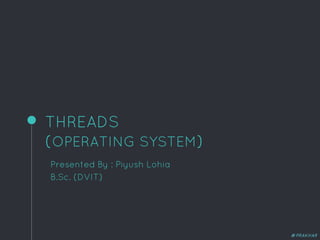
threads-ppfldkgsh;reghuiregiuhrughet.pptx
- 1. THREADS (OPERATING SYSTEM) Presented By : Piyush Lohia B.Sc. (DVIT) @PRAKHAR
- 2. What is Thread ? A thread is a flow of execution through the process code, with its own program counter, system registers and stack. A thread is also called a light weight process. Threads provide a way to improve application performance through parallelism. Each thread belongs to exactly one process and no thread can exist outside a process. @PRAKHAR
- 3. Single threaded Process and Multi-threaded Process @PRAKHAR
- 4. Difference between Process and Threads : S.N. Process Threads 1. Process is heavy weight or resource intensive. Thread is light weight taking lesser resources than a process. 2. Process switching needs interaction with operating system. Thread switching does not need to interact with operating system. 3. In multiple processing environments each process executes the same code but has its own memory and file resources. All threads can share same set of open files, child processes. 4. If one process is blocked then no other process can execute until the first process is unblocked. While one thread is blocked and waiting, second thread in the same task can run. 5. Multiple processes without using threads use more resources. Multiple threaded processes use fewer resources. 6. In multiple processes each process operates independently of the others. One thread can read, write or change another thread's data. @PRAKHAR
- 5. Advantages of Threads : • Thread minimizes context switching time. • Use of threads provides concurrency within a process. • Efficient communication. • Economy- It is more economical to create and context switch threads. • Utilization of multiprocessor architectures to a greater scale and efficiency. @PRAKHAR
- 6. Disadvantages of Threads : • Blocking of parent threads will stop all child thread. • Security.
- 7. Types of Threads : Threads are implemented in following two ways : • User Level Threads (ULT) • Kernel Level Threads (KLT)
- 8. User Level Threads (ULT) : User level thread implement in user level libraries, so thread switching does not need to call operating system and to cause interrupt to the kernel. In fact, the kernel knows nothing about user level threads and manages them as if they were single-threaded process.
- 9. Advantages of ULT : • User level threads does not require modification to operating system. • Easy to represent and manage. • User level thread can run on any operating system. Disadvantages of ULT : • There is a lack of coordination between threads and operating system kernel. • Lower performance: User-level threads rely on the application to manage thread scheduling, which can be less efficient than kernel- level thread scheduling • Limited parallelism: User-level threads are limited to a single processor, as the application has no control over thread scheduling on other processors
- 10. Kernel Level Threads (KLT) : In this method, the operating system directly supports threads as part of the kernel. Each thread is a separate entity that can be scheduled and executed independently by the operating system the kernel knows about and manages the threads. No runtime system is needed in this case. Operating system kernel provides system call to create and manage threads.
- 11. Advantages of KLT : • Kernel can simultaneously schedule multiple threads from the same process on multiple processes. • If one thread in a process is blocked the kernel can schedule another thread of the same process. • Kernel routines themselves can multithreaded. Disadvantages of KLT : • Kernel thread are generally slower to create and manage than the user threads. • Kernel requires Thread Control Block (TCB) for each thread in the pool, hence complexity increases.
- 12. Multi-Threading Models : Some operating system provides a combined user level thread and kernel level thread facility. Solaris is a good example of this combined approch. Multi-Threading models are three types. • Many-to-One Model • One-to-One Model • Many-to-Many Model
- 13. Many-to-One Model : In this model, we have multiple user threads mapped to one kernel thread. In this model when a user thread makes a blocking system call entire process blocks. As we have only one kernel thread and only one user thread can access kernel at a time, so multiple threads are not able access multiprocessor at the same time. The thread management is done on the user level so it is more efficient.
- 14. One-to-One Model : ◦In this model, one to one relationship between kernel and user thread. In this model multiple thread can run on multiple processor. Problem with this model is that creating a user thread requires the corresponding kernel thread. ◦As each user thread is connected to different kernel , if any user thread makes a blocking system call, the other user threads won’t be blocked. @PRAKHAR
- 15. Many-to-Many Model : In this model, we have multiple user threads multiplex to same or lesser number of kernel level threads. Number of kernel level threads are specific to the machine, advantage of this model is if a user thread is blocked we can schedule others user thread to other kernel thread. Thus, System doesn’t block if a particular thread is blocked. It is the best multi threading model. @PRAKHAR
- 16. “ THANK YOU !